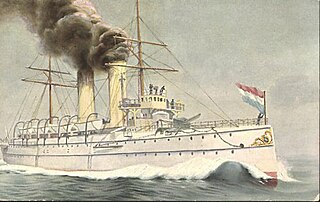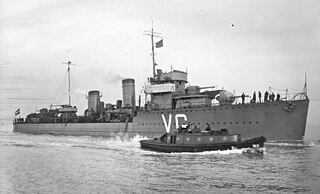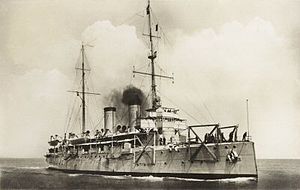
HNLMS Kortenaer was an Admiralen-class destroyer of the Royal Netherlands Navy, named after 17th century Dutch Admiral Egbert Bartholomeusz Kortenaer.

HNLMS Van Ghent was an Admiralen-class destroyer built for the Royal Netherlands Navy in the 1920s. The destroyer served in the Netherlands East Indies but was wrecked after running aground in 1942.

HNLMS Zuiderkruis (A832) was a replenishment oiler operated by the Royal Netherlands Navy. Zuiderkruis entered service in 1975 and was decommissioned on 10 February 2012. Her design was based on the earlier replenishment ship Poolster. The ship has been stripped for parts and left Den Helder for scrapping in Turkey on 21 February 2014.

The Holland class was a class of six protected cruisers of the Royal Netherlands Navy. The class was built in two groups, each consisting of three ships.

HNLMS Jacob van Heemskerck was a unique coastal defence ship of the Royal Netherlands Navy built by the Rijkswerf in Amsterdam. She was among the ships send to patrol the Venezuelan coast during the Second Castro Crisis. After her active career she was rebuilt into a stationary battery ship and recommissioned. During World War II she was captured by the invading German forces and converted in an anti-aircraft battery. After the war the ship was recovered and given back to the Netherlands, to be converted to an accommodation ship.

HNLMS Koningin Wilhelmina der Nederlanden was a unique protected cruiser of the Royal Netherlands Navy built by the Rijkswerf in Amsterdam.

HNLMS Evertsen was a Admiralen-class destroyer of the Royal Netherlands Navy. She was destroyed by ships of the Imperial Japanese Navy on 1 March 1942, during the Battle of Sunda Strait.

HNLMS Piet Hein was an Admiralen-class destroyer of the Royal Netherlands Navy, named after 17th century Dutch Admiral Piet Pieterszoon Hein.

HNLMS Koningin Regentes was a Koningin Regentes-class coastal defence ship (pantserschip) of the Royal Netherlands Navy. The ship was built at the Rijkswerf in Amsterdam at the start of the twentieth century. After the eruption of the Mount Pelée volcano on the French island of Martinique the ship provided assistance to the casualties, and then later participated in an expedition to the island of Bali in 1906. She made several journeys to show the Dutch flag and was finally decommissioned in 1920.

HNLMS De Ruyter was a Koningin Regentes-class coastal defence ship (pantserschip) of the Royal Netherlands Navy. The ship was built by the Maatschappij voor Scheeps- en Werktuigbouw Fijenoord in Rotterdam just after the turn of the 20th century. The ship participated in two colonial expeditions in the Dutch East Indies. She made several journeys to show the flag and was finally decommissioned in 1923.

HNLMS Hertog Hendrik was a Koningin Regentes-class coastal defence ship (pantserschip) of the Royal Netherlands Navy. The ship was built at the Rijkswerf in Amsterdam at the start of the twentieth century. She was the first ship in the Dutch navy to be equipped with wireless communication. The ship took part in two expeditions to South Celebes and during the Spanish Civil War she performed convoy duties. During World War II she was captured by the invading German forces and converted into an anti-aircraft battery. After the war the ship was recovered and given back to the Netherlands, to be converted into an accommodation ship.

HNLMS Holland was a Holland-class protected cruiser of the Royal Netherlands Navy.

HNLMS Zeeland was a Holland-class protected cruiser of the Royal Netherlands Navy.

HNLMS Friesland was a Holland-class protected cruiser of the Royal Netherlands Navy.

HNLMS Utrecht was a Holland-class protected cruiser of the Royal Netherlands Navy.

HNLMS Noordbrabant was a Holland-class protected cruiser of the Royal Netherlands Navy.

HNLMS Sumatra was a Java-class cruiser of the Royal Netherlands Navy. She was launched during World War I and saw action during World War II. She was scuttled off the coast of Normandy on 9 June 1944 at Ouistreham as part of a "gooseberry" pier to protect an artificial Allied Mulberry Harbour built as part of Operation Overlord.

HNLMS Java was a Java-class cruiser of the Royal Netherlands Navy. She was sunk during the Battle of the Java Sea on 27 February 1942.

HNLMS Van Galen was a Admiralen-class destroyer of the Royal Netherlands Navy, named after the 17th century Dutch Commodore Johan van Galen. She served during World War II. The opening chapter of E.H.Larive's autobiography 'The Man Who Came In From Colditz' describes in detail the craft's demise.

HNLMS Banckert was a Admiralen-class destroyer of the Royal Netherlands Navy, named after the 17th century Dutch admiral Adriaen Banckert. It served during World War II.





















